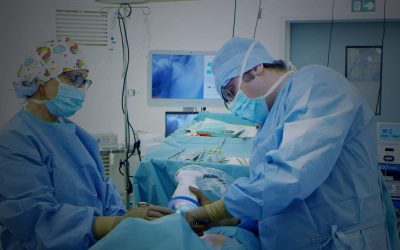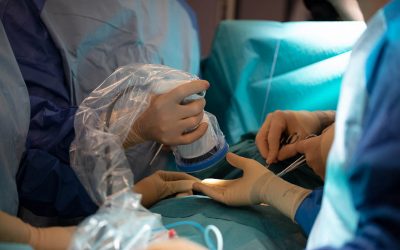In France, about 6 million people suffer from a thyroid disorder. Hyperthyroidism (which is less common than hypothyroidism) occurs when there is an overproduction of thyroid hormones, which pushes the body into overdrive. Although symptoms vary from person to person, they are easy to identify and can allow everyone to make their own diagnosis. However, only a thyroid hormone test can confirm the diagnosis of hyperthyroidism by measuring the amount of TSH in the blood (a hormone that controls thyroid activity). Here are some insights and keys to the self-diagnosis of hyperthyroidism.
Risk factors and symptoms to identify
Hyperthyroidism is characterized by an excessive secretion of thyroid hormones in the blood: increased levels of triiodothyronine (T3) and thyroxine (T4). The result is that the body’s functions accelerate. These metabolic disturbances cause a wide variety of symptoms that can be easily attributed to a dysfunction of the thyroid gland.
The causes of this dysregulation remain unknown, although a family history may play a role in the development of this condition.
Self-diagnosis: main symptoms for detecting possible hyperthyroidism:
- Unexplained excessive thirst.
- Normal appetite, associated with rapid and significant weight loss.
- Intolerance to heat.
- Hot flushes and excessive sweating.
- Irritability, nervousness.
- Difficulty falling asleep, insomnia.
- Hyperactivity and fatigue.
- Stress.
- Presence of a goiter.
- Exophthalmos (bulging eyes that protrude beyond their orbits, reduced vision).
- Frequent loose bowel movements (diarrhea).
- Heart palpitations (tachycardia).
- Tremor.
- Amenorrhea (menstrual periods that are less frequent or even absent).
All these symptoms may come on gradually, depending on the severity of your dysregulation. Only a blood test can accurately determine the level of TSH: in case of hyperthyroidism, the TSH level is abnormally low. Discover the different types of thyroid blood tests.
The causes of hyperthyroidism
The main cause of hyperthyroidism is Basedow’s disease, an autoimmune disease that stimulates the production of thyroid hormones. It can occur at any age with a peak frequency between the ages of 20 and 40.
Other causes include an excess of iodine (from food, medications), toxic adenoma, toxic multinodular goiter.
The case of Basedow’s disease
Basedow’s disease (also known as Graves Basedow disease) is an autoimmune disease that mainly affects women (between the ages of 20 and 40) although it can also occur in children. If it develops during pregnancy, it can have serious consequences for the fetus (medical complications).
The body starts to make antibodies that will attack the person’s own immune system. The antibodies will attack the thyroid cells, and more specifically the receptor of TSH (Thyroid Stimulating Hormone), a hormone secreted by the pituitary gland that regulates the functioning of the thyroid (responsible for the secretion of the thyroid hormones T3 and T4).
Orbitopathy (or exophthalmos) (bulging eyes) is one of the main features of this disease. The entire orbit is affected and exhibits the following symptoms:
- Sensation of eye irritation.
- Swollen eyelids.
- Bulging eyes.
- Double vision /reduced vision.
Read also : Treating thyroid disorders during pregnancy
How is hyperthyroidism treated?
There are three possible treatments for hyperthyroidism:
- Medication (antithyroid medications) which stop the production of hormones.
- Radioactive iodine, very effective in case of toxic nodules or Basedow’s disease.
- Surgery: removal of all or part of the thyroid gland (Basedow’s disease or presence of toxic nodules).
Complementing these treatments with a balanced and healthy diet specifically tailored for hyperthyroid patients can significantly contribute to improving overall health and managing the condition effectively.
To date, this disease remains quite mysterious because there has been very little progress in treatments and medical care.
Use of the FLUOBEAM® LX in endocrine surgery
Thyroidectomy is an operation that consists in removing all or part of the thyroid gland (by making a horizontal incision at the base of the neck). When performing this operation, identifying the parathyroid glands can be a real challenge, even for the most skilled surgeons. Due to their small size (just a few millimeters), the parathyroid glands are often difficult to detect, which may cause them to be accidentally damaged, leading to postoperative complications (hypocalcemia).
FLUOBEAM® LX is a fluorescence imaging system developed by FLUOPTICS© and designed to provide surgeons with clear and reliable information in real time during surgery. Exclusively dedicated to thyroid and parathyroid surgery, FLUOBEAM® LX has high sensitivity specifically suited for the detection of weak fluorescence signals. This innovative device thereby allows surgeons to operate under optimal conditions.
The medical protocol consists first of detecting the parathyroid glands by autofluorescence in order to locate and preserve them during thyroid resection.
The surgeon can also decide to inject indocyanine green during surgery to identify the vessels that vascularize the parathyroid glands and preserve this vascularization during thyroid resection. The result is that FLUOBEAM® LX provides clear and reliable information allowing surgeons to operate in the best possible conditions.
The symptoms of hyperthyroidism are easy to identify … The most common cause is Basedow’s disease, an autoimmune disease which mainly affects women, usually between the ages of 20 and 40. Thyroidectomy is a surgical option to be considered according to the severity of thyroid gland dysfunction … An operation that induces a certain amount of stress because of the possible postoperative complications (such as hypocalcemia, the most common, which is related to inadvertent damage to the parathyroid glands). Routine use of the FLUOBEAM® LX system could significantly reduce the rate of postoperative hypocalcemia. This reliable, easy to use device provides real-time assistance to surgeons allowing them to operate under optimal conditions.




